Clients who have experienced family and domestic violence
On this page
Key findings: Clients who have experienced family and domestic violence, 2020–21
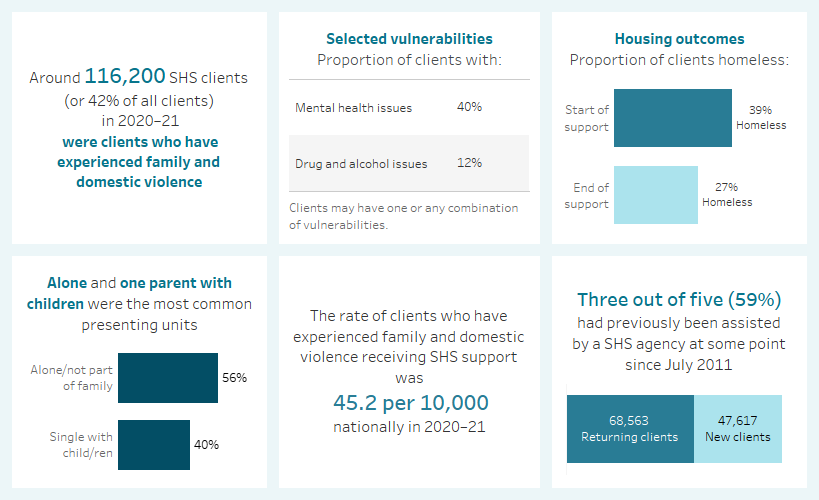
Family and domestic violence affects people of all ages and from all backgrounds, but it predominantly affects women and children (AIHW 2019). In Australia, 1 in 6 women (17% or 1.6 million) and 1 in 16 men (6% or 548,000) have experienced physical or sexual violence from a current or previous cohabiting partner since the age of 15 (ABS 2017). Approximately 2.5 million Australian adults (13%) experienced abuse during their childhood; the majority knew the perpetrator and experienced multiple incidents of abuse (ABS 2017).
Family and domestic violence is the main reason women and children leave their homes in Australia (AHURI 2021), with those who have experienced family and domestic violence making up 42% of Specialist Homelessness Services (SHS) clients in 2020–21. Since 2011–12, the number of SHS clients who have experienced family and domestic violence increased by an annual average of 4.2% (Historical data table HIST.FDV).
In March 2021, the Parliamentary inquiry into family, domestic and sexual violence found that victims-survivors of violence often bear the costs for leaving the relationship, the family home and their community (HRSCSPLA 2021). The inquiry recommended federal, state and territory governments consider funding for emergency accommodation for people who use violence (perpetrators) to prevent victim-survivors being forced to flee their homes or continue residing in a violent home (HRSCSPLA 2021).
In February 2019, the Australian Government announced $78.4 million for the Safe Places package to provide safe places for people impacted by family and domestic violence. Safe Places was designed to provide new or expanded emergency and crisis accommodation for women and children experiencing family and domestic violence. The program aimed to build up to 450 safe places and assist up to 6,500 people escaping family and domestic violence each year (DSS 2020). On 28 September 2020, it was announced that Safe Places would receive additional funding for 40 projects, as well as another $12.6 million on 11 May 2021 as part of the 2021–22 Budget (Ruston & Sukkar 2021).
SHS agencies provide a crisis response service for people who have to leave their home due to violence, yet data suggests that the pathway into stable, secure, long-term housing is challenging (Flanagan et al. 2019). Women and children affected by family and domestic violence are a national priority cohort in the National Housing and Homelessness Agreement, which came into effect on 1 July 2018 (CFFR 2019) (see Policy section for more information).
Reporting clients experiencing family and domestic violence in the Specialist Homelessness Services Collection (SHSC)
In the SHSC, a client is reported as experiencing family and domestic violence if in any support period during the reporting period the client sought assistance as a result of physical or emotional abuse inflicted on the client by a family member or if as part of any support period a person required family or domestic violence assistance.
The SHSC had information on clients experiencing family and domestic violence of any age. Changes made to the SHSC separates victim and/or perpetrators support services provided to clients. However, for 2020–21, separation of the victim and perpetrator service information is not provided due to data quality concerns that are common in the first reporting period after implementation. For more information, see Technical information.
Data quality statement note:
From 2017–18 to 2018–19, there was a three per cent decrease in the total number of Victorian homelessness clients and a 10 per cent decrease in family violence clients following years of steady increases in these numbers. The decrease was primarily due to a practice correction in how some family violence agencies were recording clients. In addition, during 2018–19, a phased process to shift family violence intake to non-SHS services began, which may result in an overall decrease in the number of SHS family violence clients over the coming years. Caution should be used when comparing Victorian client numbers over recent years. For more information, see 2019–20 SHS Data Quality Statement and 2020–21 SHS Data Quality Statement.
In 2020–21 (Supplementary table FDV.1):
- SHS agencies assisted around 116,200 clients (of any age) who experienced family and domestic violence, equating to 42% of all SHS clients.
- There was a decrease in the number of SHS clients who had experienced family and domestic violence (around 3,000 SHS clients) compared with 2019–20.
The rate of SHS clients who experienced family and domestic violence was 45.2 per 10,000 population, a decrease from 47.4 in 2016–17.
Client characteristics
Figure FDV.1: Key demographics, SHS clients who have experienced family and domestic violence, 2020–21
This interactive image describes the characteristics of around 116,200 clients who have experienced family and domestic violence and received SHS support in 2020–21. Most clients were female, aged 25–44 years. More than a quarter were Indigenous. Victoria had the greatest number of clients and the Northern Territory had the highest rate of clients per 10,000 population. The majority of clients had previously been assisted by a SHS agency since July 2011. Most were at risk of homelessness at the start of support. Most were in major cities.
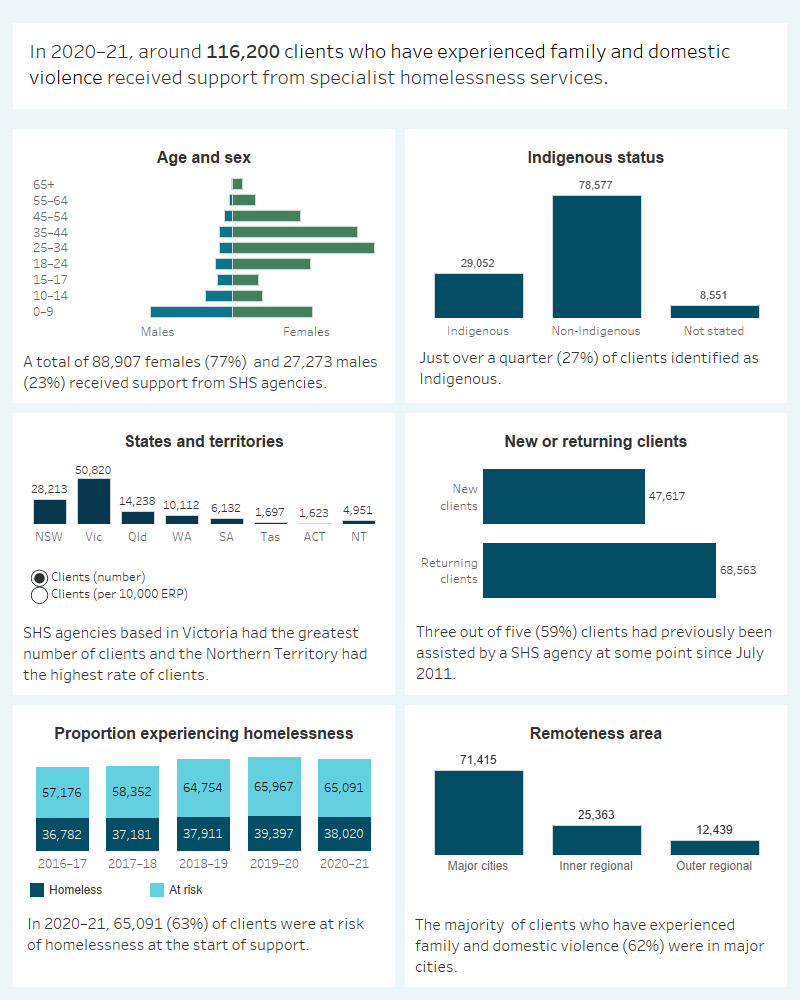
Presenting unit and Living arrangements
Children experiencing family and domestic violence may seek SHS support with their family, or independently if fleeing the home. For children in particular, SHS support is critical to reduce the likelihood of a long term experience/risk of homelessness (Kaleveld et al. 2018).
In 2020–21, clients who experienced family or domestic violence most commonly presented to a specialist homelessness agency for support alone (56% or almost 65,500 clients), or as a single parent with child/ren (40% or almost 46,800 clients) (Supplementary table CLIENTS.40).
In 2020–21, of the 116,200 clients who experienced family and domestic violence and stated their living arrangement at the beginning of SHS support (Supplementary table CLIENTS.41):
- nearly half (46% or almost 47,300 clients) were living as a single parent with one or more children
- approximately 20% (or around 20,800 clients) were living alone
- approximately 13,300 people (13%) were living with other family, which can mean a person with or without children living (in a couch surfing arrangement) with others.
New or returning clients
In 2020–21 (Supplementary table CLIENTS.38):
- Of the 116,200 SHS clients who experienced family and domestic violence, 41% were new SHS clients and 59% were returning clients who had previously been assisted by a SHS agency at some point since the collection began in July 2011. This does not necessarily mean that previously assisted SHS clients were experiencing family and domestic violence when they were previously supported.
- Of the new clients, 42% (20,200 clients) were aged under 18, 52% were aged 18–54, and 5.8% were aged 55 and over. By contrast, of the returning clients, fewer (19,400 clients or 28%) were under 18.
Selected vulnerabilities
People who experience family and domestic violence may experience other vulnerabilities in addition to experiencing homelessness, such as a current mental health issue and/or problematic drug and/or alcohol use.
Figure FDV.2: Clients who have experienced family and domestic violence, by selected vulnerabilities, 2020–21
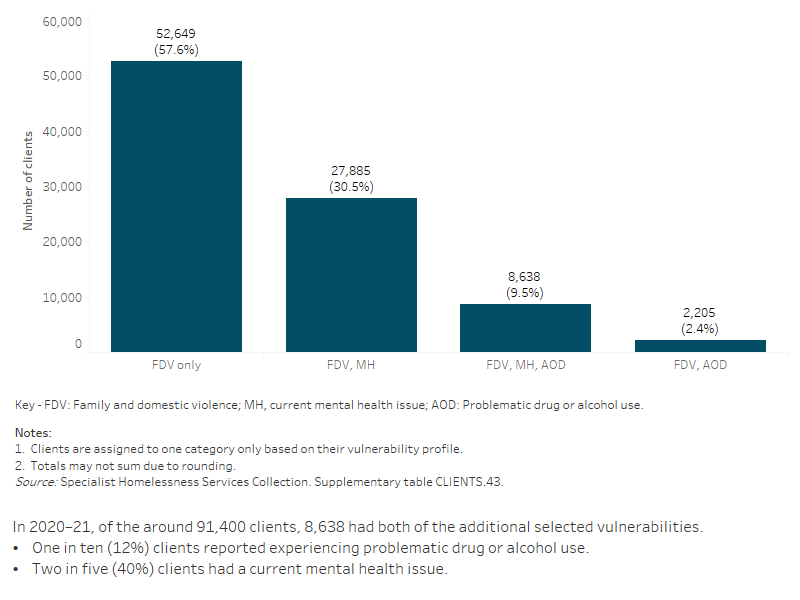
Service use patterns
In 2020–21, SHS clients who had experienced family and domestic violence received a median of 60 days of support, up from 39 days in 2016–17, an average of 2.0 support periods per client, and a median of 32 nights of accommodation (Supplementary table CLIENTS.44).
Main reasons for seeking assistance
In 2020–21, of those SHS clients who experienced family and domestic violence:
- Approximately 69% identified family and domestic violence as the main reason for accessing SHS services, while a further 8.2% identified housing crisis (Supplementary table FDV.4).
- For clients presenting at risk of homelessness, the most common main reasons for seeking assistance were (Supplementary table FDV.5):
- family and domestic violence (76%)
- housing crisis (5.7%)
- financial difficulties or relationship/family breakdowns (both 3.1%).
- For clients presenting as homeless, the most common main reasons for seeking assistance were:
- family and domestic violence (50%)
- housing crisis (14%)
- inadequate or inappropriate dwelling conditions (11%).
Services needed and provided
In 2020–21, nearly 83,000 (71%) SHS clients who experienced family and domestic violence needed specific assistance for this reason, including therapeutic discussion or group sessions, counselling and specialised support services.
Figure FDV.3: Clients who experienced family or domestic violence, by services needed and provided, 2020–21
This interactive stacked horizontal bar graph shows the services needed by clients who have experienced family and domestic violence and their provision status. Short term accommodation was the most needed and most provided service. Long term housing was the least provided by need.
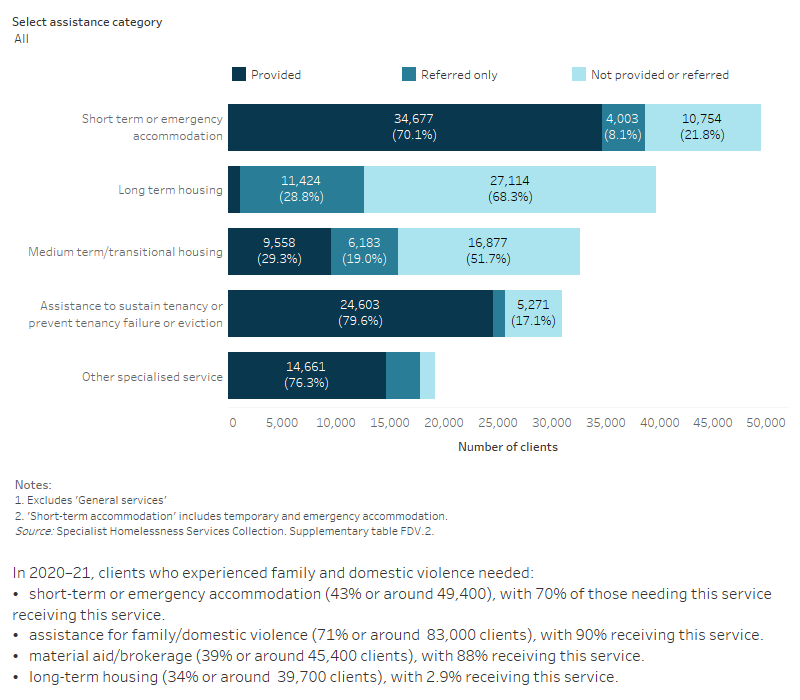
Housing situation and outcomes
Outcomes presented here describe the change in clients’ housing situation between the start and end of support. Data is limited to clients who ceased receiving support during the financial year – meaning that their support periods had closed and they did not have ongoing support at the end of the 2020–21 reporting period.
Many clients had long periods of support or even multiple support periods during 2020–21. They may have had a number of changes in their housing situation over the course of their support. These changes within the year are not reflected in the data presented here, rather the client situation at the start of their first support period in 2020–21 is compared with the end of their last support period in 2020–21. A proportion of these clients may have sought assistance prior to 2020–21, and may again in the future.
By the end of support, many clients have achieved or progressed towards a more positive housing solution. That is, the number and/or proportion of clients ending support in public or community housing (renter or rent-free) or private or other housing (renter or rent-free) had increased compared with the start of support.
For clients who experienced family and domestic violence in 2020–21, around 24,600 clients (39%) were experiencing homelessness at the start of support; 12,400 (19%) were in short term temporary accommodation. By the end of support, 73% of clients were housed (Figure FDV.4).
Figure FDV.4: Housing situation for clients who have experienced family and domestic violence with closed support, 2020–21
This interactive Sankey diagram shows the housing situation (including rough sleeping, couch surfing, short term accommodation, public/community housing, private housing and institutional settings) of clients who have experienced family and domestic violence with closed support periods at first presentation and at the end of support. The diagram shows clients’ housing situation journey from start to end of support. Most clients started and ended support in private or other housing.
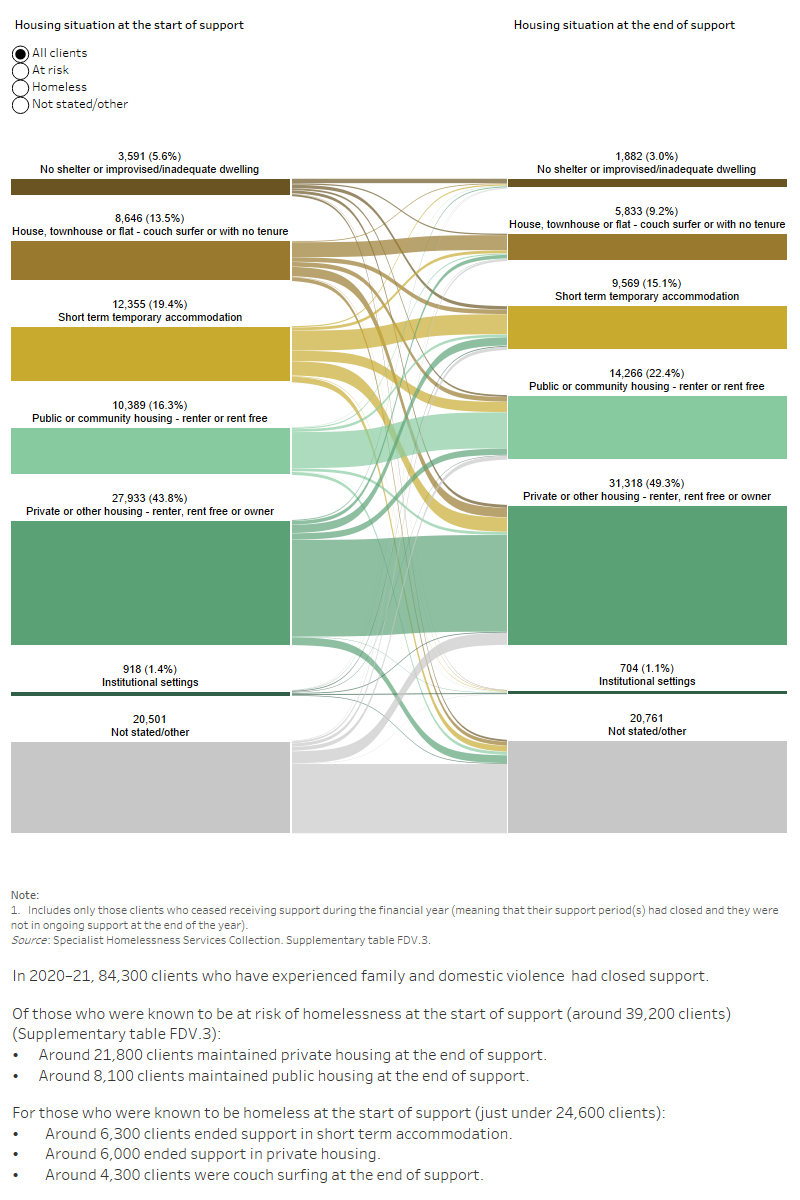
Clients accessing SHS agencies who have experienced family and domestic violence have some notable differences from other client groups. Compared with other client groups, more clients who experienced family and domestic violence were in private housing at the start and end of SHS support. Perhaps driven by their greater likelihood of presenting while housed, their service use patterns were considerably less than other client groups and they were less likely to need accommodation overall. Short-term accommodation was their greatest housing need which is in contrast to other groups which often needed long-term housing the most. This client group was more likely to be new, rather than returning clients, and more likely to experience only one selected vulnerability (family and domestic violence).
It is important to note that this analysis is based on the almost 116,200 clients of SHS agencies in 2020–21. While there are various support services available, many people do not seek advice or support after incidents of family or domestic violence. For example, data from the 2016 ABS Personal Safety Survey shows that for those who experienced physical and/or sexual violence from a current cohabiting partner, 1 in 2 women and 7 in 10 men never sought advice or support (ABS 2017). It is possible more were not able to engage with services during the reporting period due to living with their abuser during a lockdown as a result of COVID-19 outbreaks (Boxall et al. 2020).
People fleeing violence often require safe, affordable, independent housing in which to live in the long term and yet, some are unable to secure it (Flanagan et al. 2019). In the absence of an appropriate housing solution, some people may consider returning to a violent relationship (Flanagan et al. 2019). While the availability of long-term housing is a key challenge for SHS clients overall, it is particularly so for this large client group.
ABS (Australian Bureau of Statistics) 2017. Personal Safety, Australia, 2016. ABS cat. no. 4906.0 Canberra: ABS.
AIHW (Australian Institute of Health and Welfare) 2019. Family, domestic and sexual violence in Australia: continuing the national story 2019. Cat. no: FDV 2 Canberra: AIHW.
AHURI (Australian Housing and Urban Research Institute) 2021. Housing, homelessness and domestic and family violence. Viewed 5 October 2021.
Boxall H, Morgan A & Brown R 2020. The prevalence of domestic violence among women during the COVID-19 pandemic. Statistical Bulletin no. 28. Canberra: Australian Institute of Criminology.
CFFR (Council on Federal Financial Relations) 2019. National Housing and Homelessness Agreement. 2018. Viewed 18 September 2019.
DSS (Department of Social Services) 2020. Safe Places Emergency Accommodation Program (Safe Places). Viewed 5 October 2021.
Flanagan K, Blunden H, Valentine K & Henriette J 2019. Housing outcomes after domestic and family violence, AHURI Final Report 311, Australian Housing and Urban Research Institute Limited, Melbourne.
HRSCSPLA (House of Representatives Standing Committee on Social Policy and Legal Affairs) 2021. Inquiry into family, domestic and sexual violence. Canberra: Parliament of Australia. Viewed 5 October 2021
Kaleveld L, Seivwright A, Box E, Callis Z & Flatau P 2018. Homelessness in Western Australia: A review of the research and statistical evidence. Perth: Government of Western Australia, Department of Communities. Viewed 27 June 2019.
Ruston A & Sukkar M (21 May 2021). More safe places for women and children in regional and remote areas escaping violence [media release], Commonwealth Government. Viewed 5 October 2021.


